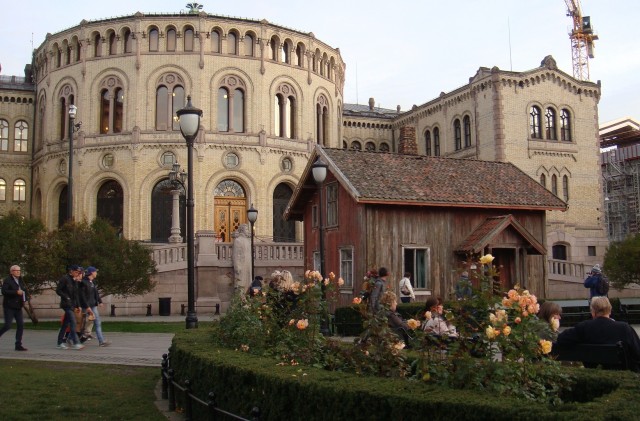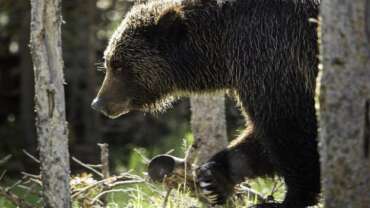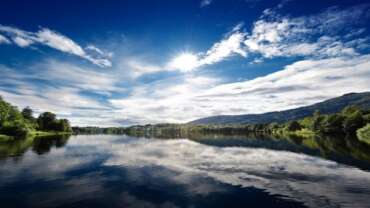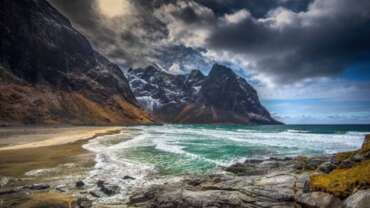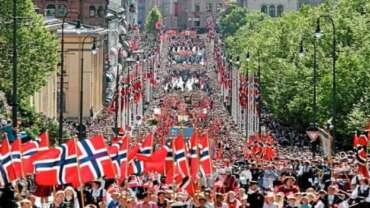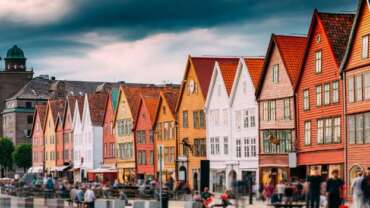Places to go in Norway
The fjords – more than a pretty façade
Pictures of Fjord Norway reveal stunning scenery with deep blue fjords, flowing waterfalls, and sharp, snow-capped mountains that tower high above the water. Here, the seals and eagles reign, and the whales and fish patrol the deep fjords.
The striking landscapes of Fjord Norway were created by a succession of ice ages, and the characteristic landscape hasn’t changed a great deal since people started living here. Fjord arms and waterfalls are accessible virtually everywhere you go, and UNESCO has included the west Norwegian fjord landscape, exemplified by the Geirangerfjord and the Nærøyfjord, on its prestigious World Heritage List.
In Fjord Norway you’ll find everything from solitary islands to some of Norway’s largest cities. A short drive is all it takes to go from urban life to quiet countryside or prime wilderness. Along every fjord, you will find small communities and villages with their own culinary specialities. The local traditions reflect what was possible to grow in each place.
Many of the region’s fertile valleys are ideal for growing fruit, and apples, pears, cherries, and strawberries are popular and common crops. Wild game, fish, or locally reared sheep form the base of many a special dish from Fjord Norway.
Tourists all over the world have Fjord Norway on their wish list, and for a good reason. If you prefer to visit the region and its many attractions without the crowds, be sure to go in autumn, winter or spring during the so-called Viking season.
EASTERN NORWAY – AN EAST SIDE STORY
The Norwegian east is booming
Ambitious architects and hard-working chefs are taking Oslo to new heights. And if that doesn’t peak your interest, try hiking to the top of Norway’s tallest mountain Galdhøpiggen and see Eastern Norway from 2,469 metres above sea level.
Combine cool city culture with wildlife experiences in raw nature. In a surprisingly short time you can get from charming coastal towns in the Oslo region via huge forests populated by moose to Norway’s absolute highest and mightiest mountains in the Jotunheimen national park, where you can even walk on smaller glaciers – on guided trips, of course.
Many kickstart their holiday in the capital of Oslo, which is also the country’s main hub for international and domestic travel. The urban vibe is boosted by new architecture, exciting food, and a lively music and art scene. The city is also a good base for day trips around the region.
Even though Eastern Norway is by far the country’s most populated region, there are vast areas of almost untouched nature and plenty of things to do outside. Why not start with compact island hopping, a boat ride on Norway’s largest lake, or fly-fishing in one of the famous salmon rivers?
The hiking possibilities are endless, with the Besseggen ridge as only one of many popular mountain routes. Cycling enthusiasts can choose between classic tour routes, internationally renowned bike parks, or leisurely biking along national cycle roads. The scenic mountains and valleys of Eastern Norway are perfect for skiing and other winter sports.
COSY TRØNDELAG
The Trøndelag region is the very heart of Norway. Placed right in the middle, with veins stretching out in every possible direction. From here, you can travel to the wild west. The Arctic north. The deep east. Or the happy south. Or you could just stay. For this is the perfect place to learn how to master the noble art of the Norwegian favourite pastime – “kos”.
Time just seems to pass a bit slower here, and many of the locals appear to move at a more laid-back pace. In Trøndelag, “kos” is just a way of life.
But what is “kos” exactly?
It can be the time you spend with your friends exploring the old wooden neighbourhood of Bakklandet in the pulsating student town of Trondheim. The region’s main city is the very capital of “kos”.
And also of jazz, cool contemporary art and funky festivals, cheesemaking monks and guys with big moustaches called “trønderbart”. Not to forget some of the most innovative tech-savvy engineers in Europe.
Trondheim is actually an incubator for cutting edge technology. Just take a look at this iconic landmark designed by Snøhetta.
Powerhouse is one of the most environmentally-friendly buildings in the world!
The 3,000-square-metre solar-panel-covered roof produces enough energy for its own building, the nearest neighbours – and all the electric city buses.
Another iconic building you shouldn’t miss is the stunning Nidaros Cathedral.
You might even meet some of the pilgrims that have hiked the famous St. Olav Ways – the main pilgrim path through Norway. The route is becoming one of the most popular long-distance hikes in Northern Europe.
Foodies from all over the world are also heading towards the culinary epicentre that is Trondheim.
The city is known as the “home of the Nordic flavours” – and for good reasons!
A few years back, Trøndelag became a driving force behind the Norwegian local food boom.
In Trondheim, you can try some of the most exquisite examples of this, for instance in Michelin-starred restaurants like Speilsalen, Credo and Fagn or at the annual food festival Trøndersk Matfestival.
But there are plenty of local gems to discover in the rest of the region as well. And yes, it is “kos” to share locally produced delicacies.
Get a taste of grandma’s hearty recipes and indulge in the local cheeses. A good start is the Munkeby Monastery – a heavenly combination of fresh Norwegian milk and traditional French cheese crafting.
SVALBARD – The realm of the polar bear
The Svalbard Islands are located in the Arctic Ocean, halfway between Norway and the North Pole. Here, you will find untouched arctic wilderness and unique wildlife in a setting that is both rugged and fragile at the same time.
Svalbard has fascinated travellers for a long time. Rich wildlife, arctic nature, and old mining towns are all found on the islands, which have a stark and eerie beauty that’s all their own.
In addition to a few thousand polar bears, the islands are home to almost 3,000 human inhabitants, over 2,000 of which live in Longyearbyen, the administrative centre and largest settlement of the islands. This small and colourful community has gone from a typical village town to a modern community with different kinds of businesses and industries, and with a surprisingly wide range of cultural activities and opportunities, such as concerts, shows, festivals and exhibitions.
Arctic food is served at a wide range of places to eat and drink of higher standards than you might expect from a small community, among them the world’s northernmost sushi restaurant. Svalbard also has a local beer brewery.
“Svalbard” means “cold coasts” and was first mentioned in Icelandic texts in the 12th century. However, the archipelago has a relatively mild climate compared to other areas at the same latitude. In Longyearbyen, the average temperature ranges from -14°C in winter to 6°C in summer. The most common way to travel to Svalbard is by plane.
Historically, both whaling and trapping have been major activities in the archipelago, but now sustainability is the guiding principle in every way: Nearly two thirds of the surface of Svalbard is protected and consists of several nature reserves, national parks, bird sanctuaries and even a geotopical protected area.



